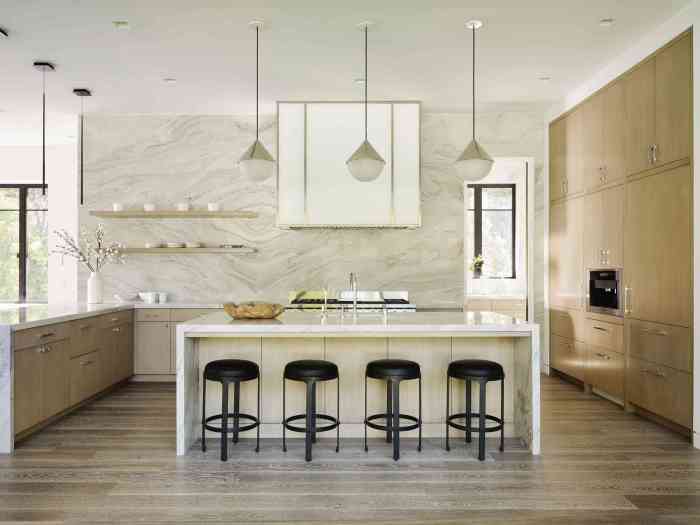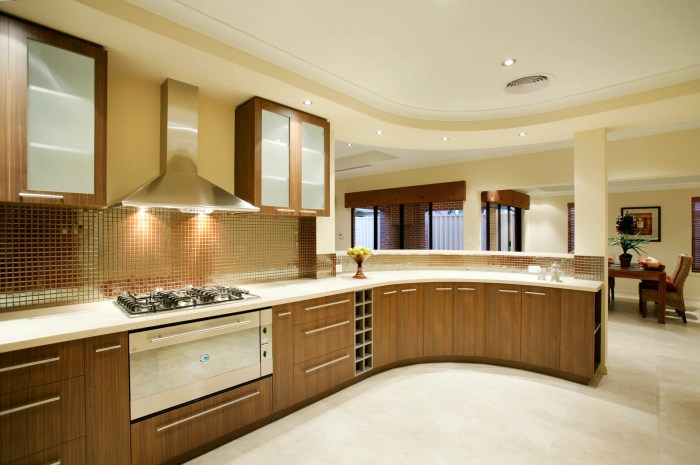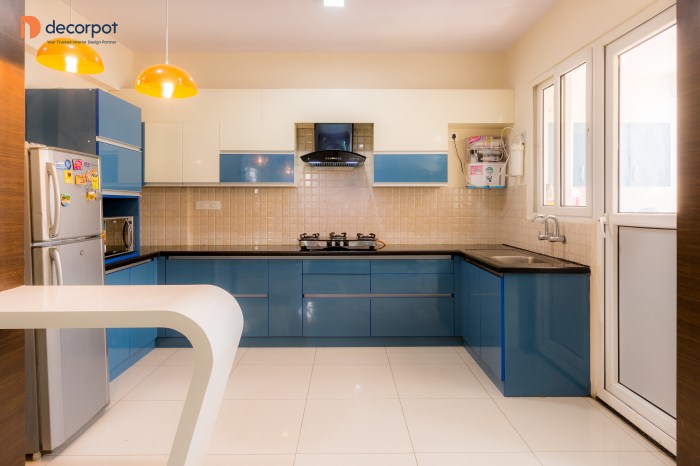Elevate Your Space: Kitchen Interior Design Ideas

Step into a world where kitchen interior design takes center stage, transforming mundane spaces into captivating havens of style and functionality. Prepare to explore the art of crafting the perfect kitchen ambiance with a blend of creativity and practicality.
Delve deeper into the realm of color schemes, layout optimization, storage solutions, and more as we unravel the secrets to a truly stunning kitchen interior design.
Introduction to Kitchen Interior Design

Interior design plays a crucial role in creating a functional and aesthetically pleasing kitchen space. It involves the arrangement of elements within the kitchen to optimize usability and enhance the overall look and feel of the area.
Enhancing Functionality and Aesthetics
Well-thought-out interior design can significantly improve the functionality and aesthetics of a kitchen. By carefully planning the layout, storage solutions, and lighting, a designer can create a space that is not only visually appealing but also practical for everyday use.
- Efficient Layout: A well-designed kitchen layout ensures that the workflow is smooth and efficient, making meal preparation and cooking easier.
- Storage Solutions: Proper storage options such as cabinets, drawers, and pantry space help keep the kitchen organized and clutter-free.
- Lighting: Adequate lighting, both natural and artificial, is essential in a kitchen to ensure visibility while cooking and create a welcoming ambiance.
Color Schemes and Themes
When it comes to kitchen interior design, color schemes play a crucial role in setting the overall mood and ambiance of the space. Different color themes can evoke various emotions and create different atmospheres within the kitchen. Additionally, the impact of natural light on color choices is significant, as it can influence how colors appear and interact in the space.
Popular Color Schemes for Kitchen Interiors
- Neutral Palette: Shades of white, beige, gray, and cream create a clean and timeless look, making the kitchen feel fresh and inviting.
- Bold and Vibrant Colors: Bright hues like red, blue, green, or yellow can add a pop of energy and personality to the kitchen, making it a focal point of the home.
- Monochromatic Scheme: Using varying shades of a single color can create a sense of harmony and sophistication in the kitchen, offering a sleek and modern aesthetic.
Creating Various Moods with Different Color Themes
- Warm Tones (e.g., red, orange, yellow): These colors can create a cozy and inviting atmosphere, perfect for gathering and socializing in the kitchen.
- Cool Tones (e.g., blue, green, purple): Cool colors can promote a sense of calm and tranquility, ideal for a serene cooking environment.
- Contrasting Colors: Pairing complementary colors can add visual interest and drama to the kitchen, making it a dynamic and engaging space.
Impact of Natural Light on Color Choices
Natural light can significantly affect how colors are perceived in a space. It is essential to consider the direction and intensity of sunlight in the kitchen when choosing color schemes. Lighter colors can reflect natural light and make the space feel bright and airy, while darker colors may absorb light and create a more intimate and cozy ambiance.
Finding the right balance between natural light and color choices is key to achieving the desired look and feel in the kitchen.
Layout and Space Planning
Efficient layout and space planning are crucial aspects of kitchen design as they impact the functionality and flow of the space. A well-thought-out layout can maximize storage, work efficiency, and overall aesthetics of the kitchen.
Optimizing Space in Small Kitchens
When dealing with limited space in a small kitchen, it's essential to focus on maximizing every inch available. Here are some tips to optimize space:
- Utilize vertical storage by installing shelves or cabinets that reach the ceiling.
- Invest in multi-functional furniture such as foldable tables or pull-out pantry shelves.
- Use light colors and reflective surfaces to create an illusion of a larger space.
- Consider built-in appliances to save counter space.
- Organize and declutter regularly to maintain a sense of openness.
The Triangle Concept in Kitchen Layout
The triangle concept refers to the positioning of the three main work areas in the kitchenthe sink, the stove, and the refrigerator. This layout is designed to optimize efficiency by reducing the distance between these key areas. The importance of the triangle concept lies in creating a smooth workflow and minimizing unnecessary movements while cooking.
By ensuring the triangle is well-planned and unobstructed, you can enhance the functionality and usability of your kitchen space.
Cabinetry and Storage Solutions
When it comes to kitchen design, cabinetry and storage solutions play a crucial role in both functionality and aesthetics. Let's explore the latest trends and innovative ideas in this aspect of kitchen interior design.
Latest Trends in Cabinetry Design
Modern kitchen cabinetry is all about sleek lines, minimalist designs, and innovative storage options. Some of the latest trends include:
- Matte finishes for a contemporary look
- Mixing materials like wood and metal for a unique style
- Integrated handles or push-to-open mechanisms for a seamless appearance
Innovative Storage Solutions
Maximizing space in a kitchen is essential, especially in smaller homes or apartments. Innovative storage solutions can help keep your kitchen organized and clutter-free. Some ideas to consider are:
- Pull-out pantry shelves for easy access to ingredients
- Corner cabinets with rotating shelves to optimize storage in awkward spaces
- Drawer organizers for utensils, pots, and pans
Materials for Kitchen Cabinets
Choosing the right material for your kitchen cabinets is crucial for durability and style. Here are some common materials used in cabinetry and their pros and cons:
| Material | Pros | Cons |
|---|---|---|
| Wood | Classic, warm look | Prone to warping and water damage |
| Laminate | Affordable, easy to clean | Can chip or peel over time |
| Stainless Steel | Modern, sleek appearance | Shows fingerprints easily |
Countertops and Backsplashes
When it comes to kitchen design, countertops and backsplashes play a crucial role in both aesthetics and functionality. Choosing the right materials and coordinating them effectively can elevate the overall look of your kitchen space.
Popular Materials for Kitchen Countertops and Their Durability
There are several popular materials used for kitchen countertops, each with its own unique characteristics and level of durability:
- Granite: Known for its durability and heat-resistant properties, granite countertops are a popular choice for many homeowners.
- Quartz: Engineered quartz countertops offer a wide range of colors and patterns, along with high durability and low maintenance.
- Marble: While elegant and timeless, marble countertops are more prone to staining and require regular maintenance.
- Butcher Block: Wooden butcher block countertops add warmth to the kitchen but may require more maintenance to prevent scratches and water damage.
The Role of Backsplashes in Adding Style and Functionality
Backsplashes not only protect your walls from spills and splatters but also serve as a design element that ties the whole kitchen together. They can add color, texture, and visual interest to the space.
Tips on Coordinating Countertops and Backsplashes for a Cohesive Look
- Consider the overall color scheme of your kitchen and choose a backsplash that complements the countertops.
- Opt for contrasting colors or materials to create visual interest and break up the monotony of a single material throughout the space.
- Choose a backsplash that is easy to clean and maintain, especially if it will be exposed to cooking splatters and grease.
- Experiment with different layouts and patterns to find the perfect combination that suits your style and personality.
Lighting Fixtures and Design
Proper lighting is essential in kitchen interior design as it not only enhances the aesthetic appeal but also plays a crucial role in functionality and safety. Adequate lighting can make tasks like food preparation, cooking, and cleaning easier and more efficient.
Types of Lighting Fixtures
- 1. Ambient Lighting: This provides overall illumination to the kitchen and can be achieved through ceiling-mounted fixtures like chandeliers, track lights, or recessed lights.
- 2. Task Lighting: Task lighting focuses on specific work areas such as countertops, stovetops, and sinks. Under-cabinet lights, pendant lights, and strip lights are common choices for task lighting.
- 3. Accent Lighting: Accent lighting adds depth and dimension to the kitchen by highlighting features like artwork, architectural details, or decorative pieces. This can be achieved with spotlights, wall sconces, or LED tape lights.
Tips on Layering Lighting
- 1. Combine Different Types: Use a combination of ambient, task, and accent lighting to create a layered effect that meets both functional and aesthetic needs.
- 2. Install Dimmer Switches: Dimmer switches allow you to adjust the intensity of the light to suit different activities and moods in the kitchen.
- 3. Consider Natural Light: Maximize natural light sources like windows and skylights to reduce the need for artificial lighting during the day.
- 4. Illuminate Different Zones: Divide the kitchen into zones (preparation, cooking, dining) and tailor the lighting fixtures accordingly to meet the specific requirements of each area.
Flooring Options
When it comes to kitchen flooring, there are various options to choose from based on your style preferences, budget, and maintenance requirements. The right flooring can enhance the overall look of your kitchen while also providing functionality and durability.
Tile Flooring
Tile flooring is a popular choice for kitchens due to its durability and ease of maintenance. Ceramic and porcelain tiles are stain-resistant and come in a wide range of colors and patterns to complement any kitchen design. It is important to choose slip-resistant tiles for safety in a kitchen environment.
Hardwood Flooring
Hardwood flooring adds warmth and elegance to a kitchen space. While it may require more maintenance than other options, hardwood is durable and can be refinished to maintain its beauty over time. It is important to choose a hardwood species that can withstand moisture and high traffic areas.
Laminate Flooring
Laminate flooring is a budget-friendly option that mimics the look of hardwood or tile. It is easy to install and maintain, making it a popular choice for homeowners looking for a cost-effective flooring solution. Laminate is also durable and resistant to stains and fading.
Vinyl Flooring
Vinyl flooring is another affordable and low-maintenance option for kitchen floors. It is available in a wide range of colors and styles, including options that mimic the look of natural stone or hardwood. Vinyl is water-resistant, making it a practical choice for kitchens prone to spills and moisture.
Cork Flooring
Cork flooring is a sustainable option that is comfortable underfoot and provides natural insulation. It is resistant to mold and mildew, making it a great choice for kitchens. Cork flooring is also eco-friendly and easy to maintain, although it may require periodic resealing to protect against moisture.
Appliances and Technology Integration

When it comes to kitchen design, incorporating the latest appliances and technology can greatly enhance the functionality and aesthetics of the space. Let's explore how these elements impact modern kitchen interiors.
Trends in Kitchen Appliances
Modern kitchens are often equipped with sleek and energy-efficient appliances that not only perform well but also add a touch of sophistication to the overall design. Stainless steel finishes and smart features are popular choices among homeowners looking to upgrade their kitchen appliances.
Smart Technology Integration
- Smart technology has revolutionized the way we interact with our kitchen appliances. From smart refrigerators that can create shopping lists to ovens that can be controlled remotely, integrating these technologies into the kitchen design can streamline tasks and improve efficiency.
- Voice-activated assistants like Amazon Alexa or Google Home can also be integrated into the kitchen space, allowing users to control appliances, play music, or access recipes hands-free.
Seamless Appliance Design
Creating a seamless look in the kitchen involves carefully concealing or integrating appliances into the overall design scheme. Built-in refrigerators, drawer-style dishwashers, and custom paneling for appliances are popular ways to achieve a cohesive look that blends seamlessly with the cabinetry and countertops.
Conclusive Thoughts

As we draw the curtains on this insightful journey through kitchen interior design, remember that a well-designed kitchen is not just a space for cooking but a reflection of your unique style and personality. Let your culinary adventures be guided by the beauty and efficiency of a thoughtfully designed kitchen interior.
FAQ Section
How can I enhance the functionality of my kitchen through interior design?
By optimizing the layout, incorporating smart storage solutions, and choosing practical materials, you can significantly enhance the functionality of your kitchen space.
What are some popular color schemes for kitchen interiors?
Popular color schemes include classic white, earthy tones, bold blues, and elegant neutrals, each creating a unique atmosphere in the kitchen.
How important is lighting in kitchen interior design?
Proper lighting is crucial in kitchen design as it not only affects the ambiance but also plays a key role in enhancing functionality and aesthetics.
What are the latest trends in kitchen appliances for modern interiors?
Modern kitchen appliances are focusing on sleek designs, energy efficiency, and smart features that seamlessly blend into the overall kitchen design.

